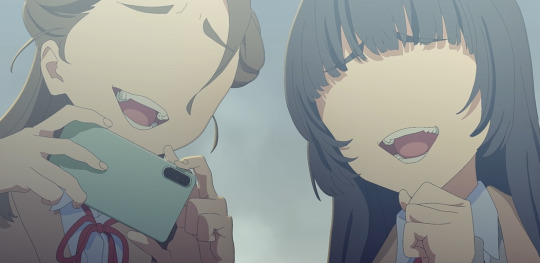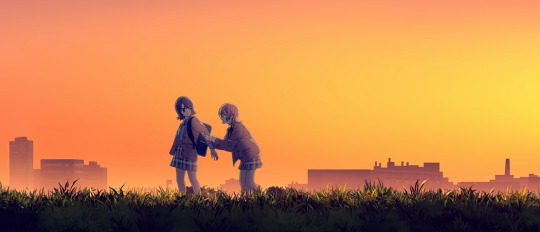Text

Double thumbnail is out! I'm afraid.
Something that immediately caught my attention here is how, despite the bloodiness of the scene, Mikoto's clothes and bat are perfectly clean. Is he really the one who broke these mannequins, or is something else going on here...?
#milgram#sorry for the complete lack of posts for the past several months#been busy with college and it's hard to articulate analyses when i'm not hyperfixated on milgram#and also i've been struggling with “this is probably obvious so who cares” types of thoughts regarding said analyses#but hopefully i'll have more free time soon to say fuck it to that and post anyway#i really want to write paragraphs on amane before her verdict is confirmed
20 notes
·
View notes
Text
HI THOSE EYES ARE FAMILIAR


#MILGRAM#IT'S NOT AN EXACT MATCH OBV BUT THE INTENT OF EXTREME FAITH IS VERY MUCH APPARENT IN BOTH#I WAS GONNA MAKE AN IN-DEPTH KAZUI ANALYSIS POST BUT FUUUUUUUUUUCK#FUUUUUUCK THIS IS THE BEST NEWS EVER#AMANE MOMOSE
48 notes
·
View notes
Text
Watched I Love You this morning, been thinking about it all day, and now that I've got time to cram all my disorganized thoughts in a Tumblr post, here they are!

The symbolism in this one is pretty straightforward: Mahiru and her boyfriend had an idyllic relationship on the surface, but in reality, their relationship was deeply unhealthy. Mahiru's love became overbearing (as it was the only solution to their problems that she knew), and her behavior and the state of the relationship pushed her boyfriend to suicide. The cake represents their love, the rats represent the toxicity beneath the illusion, in the woods they're both lost...again, it's straightforward, so I'm gonna dedicate this post to some of the details I've been thinking about.

The carousel is, I'm pretty sure, primarily a representation of the feedback loop of the codependency of the relationship. At least, I'm certain that's what the specific nature of their relationship was, considering Mahiru's whole "give and take" deal: a theme that's shared with Shidou, her counterpart. He takes (organs) until it can’t save his family, and she gives (obsessive love) until it suffocates her partner.



It also just adds to the visual representation of "Mahiru's idea of love and this relationship is a fantasy." By the time they're both worn out, the boyfriend "wants to get off the ride." But he can't-- presumably because the codependent nature of the relationship makes him just as attached as her. Considering the “Clothes Food Shelter” line, maybe he was also materially dependent on her as well.

This Is How To Be In Love With You heavily implies that Mahiru has some sort of great emotional turmoil deep down ("I suck at pretending to smile / But see! I feel great because of you," although this line in particular and her insistence that she isn’t in physical pain in her voice drama could also point towards codependency), and her insistence on hinging her identity on the concept of love definitely isn't a good sign for her mental health. I suspect her boyfriend was similarly struggling, even before the relationship got so bad that he turned to suicide. There's a couple of lines in This Is How To Be In Love With You that refer to mutual pain, and the Corpse Reviver recipe could be symbolic of the boyfriend (or Mahiru, or even both of them) being "revived" from feelings of hopelessness or depression by love.


It's interesting to me that the rat poisoning scene is even there in the first place, because I think "being stuffed with cake even after you become ill from it, as its delicious taste no longer matters and all you can think about is how unhealthy it is" is a very fitting metaphor for this relationship on its own. Probably just to hammer in the "delusion/perception vs reality" thing, and how Mahiru’s actions came from both her fantastical idealism and her lack of self-awareness. Obsessing over Believing in the power of love “saved” her by giving her a reason to live, so surely it would save her boyfriend no matter what, right?

Speaking of which, the spirals in Mahiru's eyes here create a familiar color palette!


Finally, I’m not sure how to segue into this, but one thing that’s been bugging me is that... I have no idea why the boyfriend's body is wet in the first scene of the music video? Especially since it's dry by the end of it?

I’m sure others have probably come up with explanations, but I’m way too tired and busy to keep fixating on Milgram right now and I don’t even know how important it is in the end. Maybe I’ll come back to this later.
20 notes
·
View notes
Text




so forests, huh
#milgram#took these screencaps on mobile so they probably look like shit i'll update them later#the point here is that maybe the woodsy setting we see in the thumbnail is going to be more than just symbolic...
63 notes
·
View notes
Text
Extremely disorganized train-of-thought Mu notes! I'll try to put together a more comprehesive post at some point, but just to get all my thoughts out and strike while the iron’s still hot:
The ending is what’s fucking me up the most right now. I...don’t know what to make of it yet. The hourglass thing is definitely symbolic of the “tides turning” against Mu, but this frame in particular...


...Matches this one in Undercover.

There’s two different messes in After Pain and It’s Not My Fault. The one in After Pain is probably Mu’s, as indicated by her boxcutter. Would the second one be her victim’s, then? And if there's two messes, does that mean Mu was also pushed? It could be purely metaphorical, something something "what goes around comes around," but also most (if not all) of the silhouettes in that one segment of Undercover are of the prisoners.
One of the whiteboard notes apparently implies that the flowers were left on Mu’s desk as an insult (source), but based on how the sunlight hits the classroom, the desk that the flowers are on...doesn’t seem to be Mu’s desk?


But if the flowers are for the victim (let’s say Mu only received the ones she’s holding in that frame) and their presence at the end of It’s Not My Fault is symbolic of them “haunting” Mu (I’ve seen theories that her murder is what caused Mu’s bullying, but I doubt she’d even still be at school if that were the case, and she stated in Crying B that the murder is the last thing she remembers before waking up in Milgram), why is she soaking wet as though she just stood up from the mess, a frame which we know is probably literal based on Undercover-- would that not imply this scene "takes place" while she's still alive? When Mu denies being a bully in Queen B, she specifically says she’s “never dumped water on anyone,” which could be a reference to the bathroom scene in After Pain, but could it also imply that she’s denying being involved in bullying her victim faced?
Was Mu’s victim bullied? In the bug scenes, she witnesses Mu and her friends dancing on the remains of the girls she “shattered,” and the very next scene is the one where Mu looks behind her while bullying someone on the rooftop. Notably, she’s human in the bug scene-- a complete outsider.

Speaking of the bug scenes, there’s repeated emphasis on the cocoon that Mu hatches out of after she commits murder-- specifically after re-declaring herself as queen. People have already pointed out that the wings are representative of her freedom from torment, but perhaps it’s not just about her metamorphosis, it’s about the re-emerging of “the queen” itself, and that’s why Mu’s eyes change there.
Wrapping back to the flowers, there’s a note on the table that wasn’t there in After Pain.

Makes me think of this.


===
Revisiting this draft several hours later, I saw an old theory (credit to sassyangelchild for finding and making a post about it) postulating that the final frame of After Pain is actually Mu bullying the victim, hence her holding the flowers and the “reeks of poverty” and “playing the heroine” notes on the chalkboard, which...would make a lot of sense, actually, especially since the drawings on the board resemble the victim slightly more than Mu.
I barely even processed the vengeance-related mental gymnastics in Queen B. I'll either update this post or make a separate one once I revisit that.
So then, is the fact that she was human in the bug segment representative of her being “indestructible” unlike those Mu shattered? And what did she do to destroy Mu’s reputation? I don’t agree with the theory that Mu deliberately staged or faked being bullied-- again, I think her having gone through it is important to her gray morality, and as unreliable of a narrator she may be, the music videos are taken from her memories and I think it’d be odd if the prisoners had any control over them.
2 notes
·
View notes
Text
at least that mu post was like 99% finished before tumblr decided to post it despite me clearly pressing the "save draft" button
#-_-#anyways. finally tagged my first two theory posts!#it is very scary releasing my gay little thoughts into the wild but i don't want this blog to just be an echo chamber
0 notes
Text
The It's Not My Fault thumbnail is out! Gorgeous art aside, here are my thoughts:

I'm starting to think that the girl Mu killed was bullied by her in the past.
Hear me out. We get very clear shots of three of the girls who bully Mu, right?


And then we see them (I think all three of them, but it's a little hard to tell with the darker-haired girl) in the group selfie on Mu's phone. These are her ex-friends.

Mu's groupchat has four people in it. Just enough for everyone in the photo, implying that the photo is the extent of this friendgroup.

...So then, who's the bystander?

It doesn't seem like she's part of this friendgroup, nor does it seem like she's part of the bullying either (she's comimg out of the stall when she sees Mu on the floor in front of her, so it seems like she's only there by happenstance). Why would Mu kill her? What's going on in this scene?

I have two possible explanations. Either Mu is reaching out for help here and she snaps when she's denied it...or she's apologizing.
We've seen plenty of Mu's true colors, both since the beginning of Trial 2 and in her first voice drama: she's bratty, self-centered, and insistent that she always deserves what she wants. Put that kind of behavior in a school setting, and it's...not difficult to envision her being part of a posse of bullies.
Let's go back to the It's Not My Fault thumbnail:

Of course, I can only guess what's actually happening here, but the girl on the right seems to be reassuring Mu, who looks rather concerned at whatever's behind her. Remorseful, perhaps?
Here's my theory: Mu and her friends used to bully the girl who'd become her murder victim. Mu grew a conscience and eventually objected to it, which led to her either having a falling out with her friends or becoming the "butt of the joke" of the group, constantly picked on by them for being an annoying nag.
When she saw the girl she bullied walk past her, she ran up to her and tried to apologize for everything. Her victim, perhaps seeing her as ingenuine or just not having any sympathy for her, pulled away...and we all know what happened next.

It's worth noting that the girl in the back near the fence in It's Not My Fault's thumbnail doesn't look like any of Mu's established friends or her murder victim. This could be a point against this theory, but it could just as equally mean that Mu and her friends bullied multiple people.
It'd tie into the lyrics of After Pain, too: "'I'm sorry' won't reach anyone" could refer to her victim refusing her apology, the other people at school still seeing her as a bully, and, of course, her friends picking on her. Interestingly, it'd also make her story very similar to Futa's, just told in a reversed order: we saw Futa's cyber-harassment first and then his extreme remorse, so if this theory holds up by next week, we'll have seen Mu's extreme remorse first and then her involvement in harassment.
Either way, I'm excited as hell!
#milgram#mu kusunoki#milgram theory#again i apologize if this is all like obvious as shit or is an already common theory#and ftr i don't think this would mean the bullying she went through was 'deserved' or w/e#i think mu having Gone Through Hell is crucial to her story and gray morality and i doubt it would just be thrown away for a Gotcha!#hell if anything despite the eyebrow-raising chorus lyrics i wouldn't be surprised if this mv still portrayed mu in an a sympathetic light#not just because it's Her perspective but to make people second-guess themselves after readying#to vote her guilty for the past 5 months#edit: added higher-res screenshots
15 notes
·
View notes
Text
The halo effect on the Triage album cover is really interesting to me. There's been a light shining above the prisoners in all the album covers up to this point, but until now, they've always been beaming directly downward, and none of them have produced a halo like this.

My immediate thought was that this could be representative of him being an "angel of death"-- as in, a caretaker who murders his patients. Considering how his surname may or may not be a reference to Jack the Ripper and the fact that he's mentioned having a kill count...yeah, I'll add this onto the pile of "foreboding Shido details."
It could also be symbolic of him trying to "play god" by cheating death? Assuming the last scene of Throw Down is literal and taking into account his "she's definitely not dead" line from the Trial 1 voice acting teaser.
Either way, I would not be surprised if Triage turned out to be particularly fucked up. If we're being given such a blatant reason to vote him forgiven right out of the gate (he's the one who can heal the prisoners), surely something's coming up to serve as an equally blatant reason to vote in the other direction...
#i'm running on fumes from accidentally pulling an all-nighter rn#so if this is like surface-level shit or smth's flying over my head here then uh. Whoops#milgram#shidou kirisaki#milgram theory
7 notes
·
View notes


